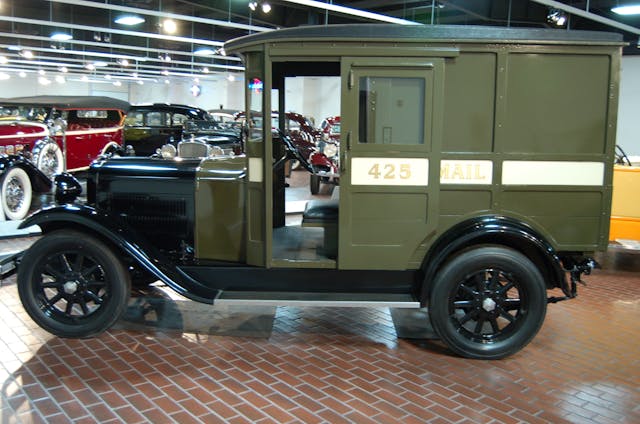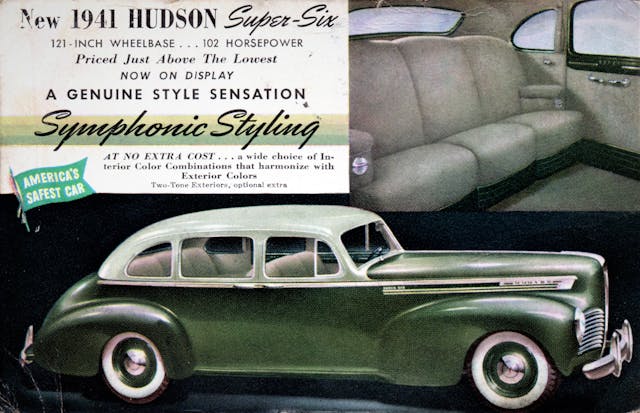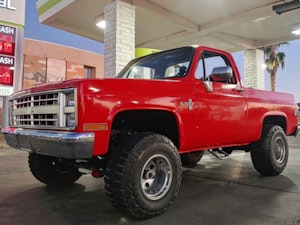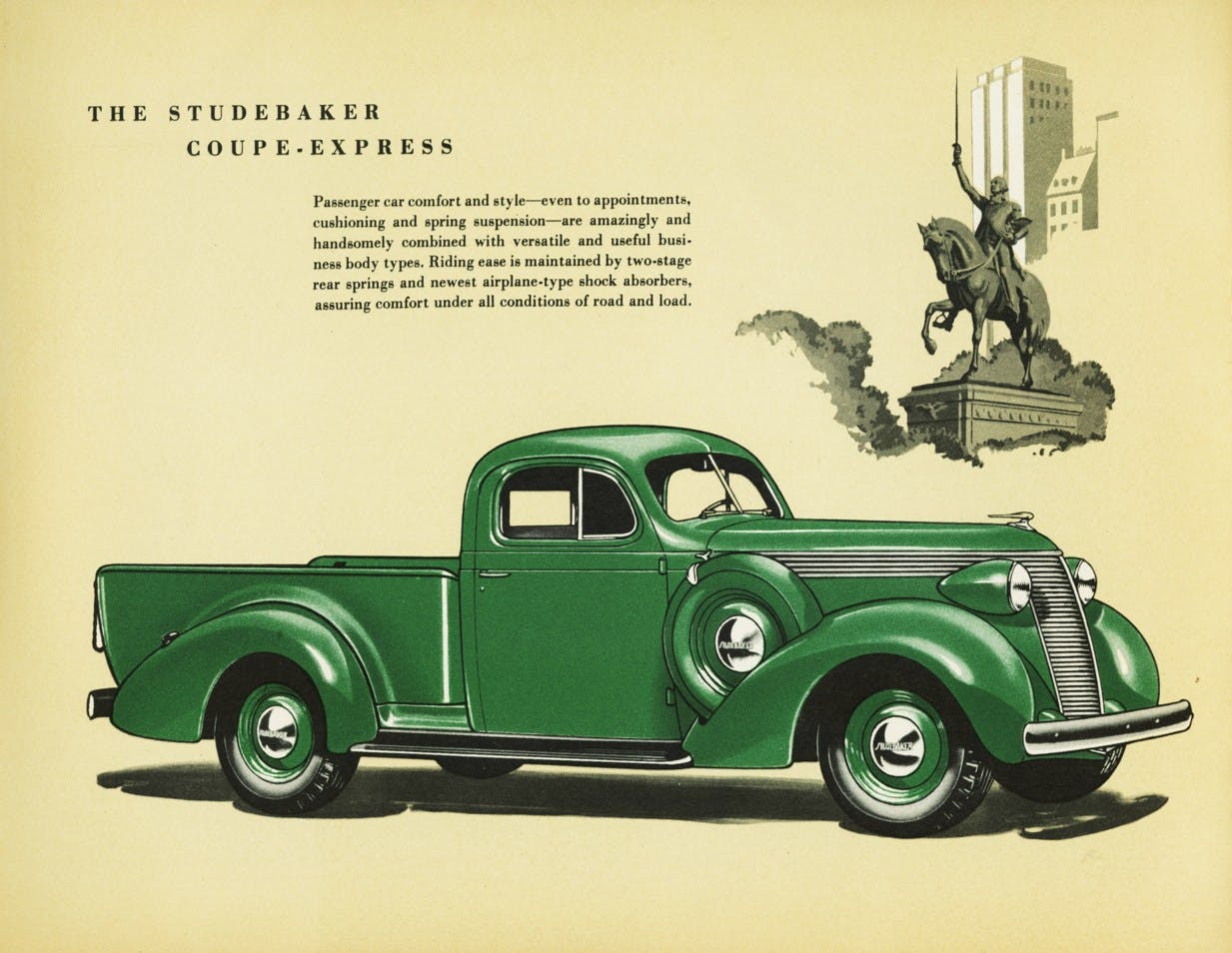Media | Articles
Did Ute Know? The first car-based pickup was not a Chevy
For a group that likes to call themselves car people, automotive enthusiasts have an odd affection for cars that look like trucks: The Chevrolet El Camino, the Ford Ranchero, and the Subaru Brat.
Whatever you call these oddities—car-truck, truck-car, cowboy Cadillac, ute—it’s tempting to say that they trace their lineage back to Henry Ford and the 1917 Model TT truck. Though early Ford cars and trucks are obviously related, the TT was a purpose-built utility vehicle with a more substantial frame and drivetrain. Typically, car-based trucks have gone in the other direction, borrowing their mechanicals from automobiles, not trucks, and tilting the utility/luxury balance more towards the latter.
So, if not the Model TT, which vehicle is the true founder of the car-truck line?

Since I haven’t done a Marianas Trench–level dive into the subject, I can’t say with 100 percent certainty that it was independent automakers Studebaker and Hudson that first introduced actual car-based pickup trucks to the American market. However, I believe that the 1937–39 Studebaker Coupe Express and the 1941–47 Hudson Cab Pick-up (including the 3/4 ton “Big Boy” models) are among the very first American vehicles that combined pickups’ cargo beds with the styling, sheetmetal, and mechanical componentry of those brands’ passenger cars.
Introduced for the 1937 model year, the Coupe Express was based on the Studebaker Dictator. In case you’re wondering why Studebaker would choose a model name associated with despots, the Dictator nameplate was introduced in 1927, before Hitler, Mussolini, Franco, and Stalin had solidified the word’s modern connotations. If the branding scheme is now awkward, it was at least coherent: Dictator was the entry-level Studebaker, below the midrange Commander and flagship President.

Marketplace
Buy and sell classics with confidence

Power was supplied by Studebaker’s larger, 218-cubic-inch (3.6 liter) L-head inline six-cylinder producing 86 horsepower, driving through a three-speed manual transmission, with an optional Borg-Warner overdrive available. Typical passenger-car options like radios, heaters, and turn signals were available. You could even choose from two different styles of steel wheels. (Yes, young Padawan, things like heaters and turn signals were not always standard equipment, let alone air conditioning. Before the 1976 Honda Accord, cars were very much priced à la carte.) About 3000 units of the introductory Coupe Express were sold. Advertising touted the “passenger-car comfort and style … combined with useful business body types.”
For the 1938 model year, the cab of the Coupe Express was updated to reflect styling changes on the passenger cars. In this case, styling alterations made the vehicle more practical: They allowed for a slightly longer cargo bed, which featured a sharp-looking, backwards-sloped tailgate. Despite the styling changes, sales dropped by almost two-thirds to around 1200 trucks. Again, the 1939 models were restyled to reflect Studebaker’s cars, but sales of the utes dropped even more, to just about 1000 units. The Coupe Express was discontinued to be replaced in 1941 by a 1/2 ton model of Studebaker’s more conventional M-Series pickup in 1941.
Hudson, on the other hand, never developed a dedicated truck line. You could well argue that all of Hudson’s pickup trucks, in fact all of its light commercial vehicles, were car-based. This wasn’t a bad thing, since Hudson’s automobiles were regarded as robustly overbuilt; perhaps they were suited well for the task of being car-truck hybrids.
In 1929 Hudson’s Dover truck brand started selling a line of commercial vehicles based on the parent company’s Essex automobiles, equipped with pickup beds, side-express bodies, or custom bodies made by the Hercules company in Kentucky. The United States Postal Service was a major customer, buying 500 of the car-based trucks, presumably for mail delivery. One of those postal utes, shown below, long resided at the Hostetler Hudson Museum in Shipshewana, Indiana, which closed in 2018.

Hudson also sold those same vehicles under the Essex brand, with slight changes. In 1932, a new line of pickups and sedan deliveries were offered, based on the Terraplane. With the Great Depression going on, sales were modest and peaked at about 8000 units in 1937.

That year, Hudson’s lineup of what it called Commercial Cars was expanded to also include a cab and chassis model, a sedan delivery, a station wagon, plus a “Utility Coupe,” which had a small pickup box that pulled out like a drawer from the trunk, and a “Utility Coach,” a two-door sedan with removable seats and panels to cover the rear quarter windows.
For the 1939 model year, the lineup was expanded yet further, offering three different wheelbases and multiple trim levels, all of them with car styling. That year the heavy-duty 3/4 ton Big Boy trucks were introduced. In 1940, when Hudson cars got new front-end styling and A-arm front suspensions with coil springs, the trucks shared those modern developments.
The Hudson trucks introduced in 1941 were probably the most car-like. Hemmings describes them as “low, long and dripping with chrome,” looking “like something dreamed up by a customizer… rather than the product of a mainstream American automaker.” Contemporary advertising focused on “new beauty and style,” plus “passenger car roominess and comfort.”

The fact that the ’41 Super-Six is considered by Hudson enthusiasts to be one of the marque’s most attractive products didn’t hurt. The half-ton Cab Pickup and the three-quarter-ton Big Boy models were based on 116- and 128-inch wheelbase versions of the Super-Six Commodore. Though those were midrange cars, they had substantial frames with 7 3/8″-inch tall rails and four lateral crossmembers augmented by a stiff X-member. The independent A-arm, coil-sprung front end was billed as “Auto-Poise Front Wheel Control,” the rear end had leaf springs with a track arm, and all four corners were dampened with modern hydraulic tube-type shock absorbers. The trucks did feature stiffer springs than the passenger cars and the Big Boy’s brakes 11-inch drums came from the parts shelf for the Hudson Eight.

The Hudson pickup may have been based on a sedan, but even the shorter-wheelbase model had a full-steel pickup bed measuring more than 48 inches between the inner fender walls and 93 inches front to back: With the tailgate down, you could carry a full sheet of plywood. On the inside, the dashboard offered the sedan’s clock, “Weather-Master” heater, Zenith radio, and deluxe steering wheel with a chrome horn ring as optional features. Super Six mechanicals were included as well, with Hudson’s 212-cubic-inch inline six driving through a column-shifted three-speed transmission that, like the Studebaker’s, was also available with an overdrive.
The war-shortened 1942 model year introduced Super Six sedan features such as slicker, restyled fenders and a flared lower body to hide the running boards. As with most cars in the immediate postwar period, the 1946 models were much like the prewar cars except for a new grille. The pickups, although they were some of the first postwar vehicles that Hudson made, still retained the earlier body style with exposed running boards—possibly due to their lower volume compared to the cars.
When Hudson introduced its innovative “Step-down” 1948 models, the firm stopped making pickup trucks as they were not compatible with the new model’s semi-unibody construction. While one prototype was reportedly developed, Hudson would never make another production pickup truck, car-based or otherwise, again. The company would merge with Nash to form American Motors in 1954.
Can we say with absolute certainty that Studebaker and Hudson made America’s first car-based pickups? No, but one thing’s for sure: Chevrolet and Ford were fashionably late to the party.
***
Check out the Hagerty Media homepage so you don’t miss a single story, or better yet, bookmark it. To get our best stories delivered right to your inbox, subscribe to our newsletters.
















Coupe Utility 1934 Ford Australia is the bed integrated into the body, aka what the U.S. automakers did with Ranchero and El Camino 20+ years later. We’ve had a modern version of this for sometime in the Honda Ridgeline (crew cab like everything else truck these days). The Maverick and Santa Cruz and more? joining the party is good in my view. These are “utes”.
I agree with the earlier posters about the brass-era stuff kind of being their own thing.
By the 1930s, truck bodies were quite upright. Some of them look great in hindsight (40 Fords…). The Hudson and Stude designs are lower looking and sleeker (I especially like the Stude). They are not utes though. Later Stude trucks are really nice through the 50s to my eyes (not the Lark-based to me).
car-based and ute aren’t mutually inclusive terms to me. The unibody F100s of early 60s are neither. Modern trucks with coil spring suspensions (like 60s C10 had…) and posh interiors aren’t either either (there’s a mouthful) even though they ride more car like than most things made before 1970.
Wow I never knew the truck started off as a ute I thought it was just a pickup I never knew it was a coupe ute per say
I always thought of the ute as the El Camino or even the Falcon and Commodore in Australia
“Ford Australia was the first company to produce an Australian Coupe ute, which was released in 1934. This was the result of a 1932 letter from the unnamed wife of a farmer in Australia asking for “a vehicle to go to church in on a Sunday and which can carry our pigs to market on Mondays”. In response, Ford designer Lew Bandt designed a two-door body with a tray at the rear for the American Ford Model A chassis, and the model was named “coupe utility”. When the Australian version was displayed in the US, Henry Ford nicknamed it the “Kangaroo Chaser”.
I’ll just leave this Wikipedia link here, https://en.m.wikipedia.org/wiki/Ute_(vehicle)#:~:text=Ford%20Australia%20was%20the%20first,pigs%20to%20market%20on%20Mondays%22.
Ford Australia had the Coupe Utility in 1934….
You’ve got it totally wrong. A light duty commercial vehicle is NOT a Ute.
Ford Australia was the first not hard to find the story
I had a 36 Ford 3 window coupe that had a factory made pickup bed in place of the trunk. I think it had been built for utility companies.
All the replies are mostly WRONG. The “ute” was invented in 1927 in australia by ford.
Your welcome.
It all started with a letter: i am a farmers wife and want a vehicle that they could take their pigs to market and go to church in.
It was based on a model A body not a model T. Making it a single construction body.
It was styled by lewis bant.
He also made a few fastback versions of the mk1 ford cortina ive heard 5?
And a 4 door for his wife.
Try looking up Ford Australia around 1936/7
Seems everyone completely missed the car-based 1937 Plymouth pickup. They were built from 1937 to 1942.
As a child, I so remember an Uncle having an old ( 30’s or 40’s) Plymouth pick up. I still remember the hood ornament, Like the Mayflower ship or something. Memorable.
Another distinction (mentioned by a few above) is the integrality of the ‘cab’ section (car-based or not) and the ‘bed’ section: what is often referred to as ‘Unibody’ or ‘flow-through’ styling and construction. I’m not expert on the ‘Ute’ body style, but mostly those seem to conform to the ‘unibody’ type, huh? It’s a useful distinction, but then we are chucked into the middle of a ‘pickup truck vs. car’ distinction. Not too many pickup manufacturers have hewed to this style — Fords in the ‘sixties, along with the limited production Datsun NL320; and the pretty Cameo from Chevy/GMC was definitely did not — because of limited appeal and also manufacturing complexity, I assume. Here again; the F100 version was distinctly a truck, and the Datsun based on their station-wagon car body.
A problem common to most ‘Ute’ type coupe/pickups isn’t mentioned, but it looms hugely in regards to survivability and restorability: moisture inside the body. Perhaps in Oz the rains were light enough that accumulated water pooling in the bed floor and car floor pans/structural stampings wasn’t a big factor, but in much of the world, the seasonal dousings from precipitation had to be a constant challenge to body integrity. Heck, even washing the things could cause the same problem, especially as leaves and crud accumulated as they always do in older rigs plugged the drain holes and vents. I recall numerous home-made coupe/express pickups (take on old coupe or roadster, jettison the deck lid (and/or rumble seat) and build a bed of wood and tin, and you have a farmer’s delight, a free quarter-ton pickup truck. Seen plenty of those, alas! The separate cab/bed option mostly precluded that fate. A look at the factory bed-conversion coupes brings that liability to mind. Makes for a complicated restoration. Wick
Is Hagerty interested in article submissions? I’ve written for Hemmings SPECIAL INTEREST AUTOS, Old Cars, Street Rodder, and a number of other smaller journals, some now defunct (not my fault, I hope!) and did HOW TO RESTORE YOUR DATSUN Z-CAR (CA Bill’s Automotive Handbooks, Tucson AZ, 1990) which has been in print for 33 years, and is coming out in a completly revised edition. Also, fiction: the A PLACE ON MARS series on Kindle ebooks and paperbacks, 2023 — lots of cars featured in nostalgic adventure stories.
I have ten or so one-thousand word articles I can submit for scrutiny, if so. Wick, age 78
Just came back from a cars&coffee where there was an Austrailian Ford A based Ute with unified cab and ‘bed’ from 1937 (now converted to L.H.D. as the current owner prefers for use here in US). That Ford would predate the other car/trucks.
Then the fine print… “American market” paragraph 3, and “America’s first car-based pickups” in the closing line, so yeah, with those conditionals added that late 30’s Aussie Ford Ute can’t be counted.
I have to agree with some of the previous comments about your facts. Since I am a current owner of a 1934 Chevrolet Holden Ute, (for sale) based on a 34 Chevrolet coupe body, how does it not qualify as an earlier than 1941 vehicle. It’s also a unibody, bed and cab is all one unit, which I don’t think either of our later models were.